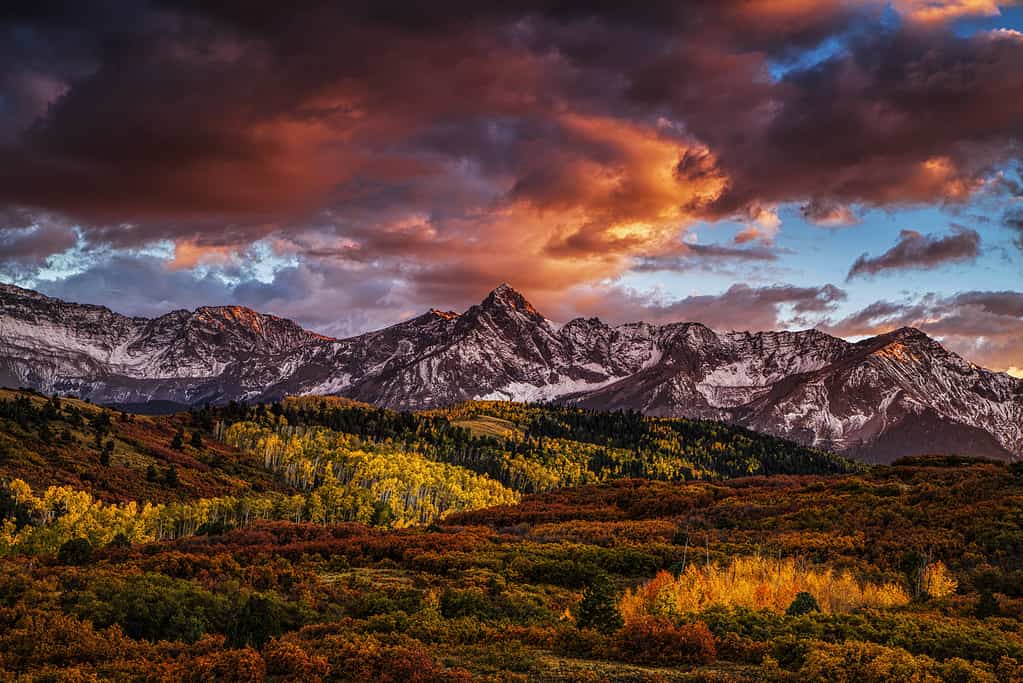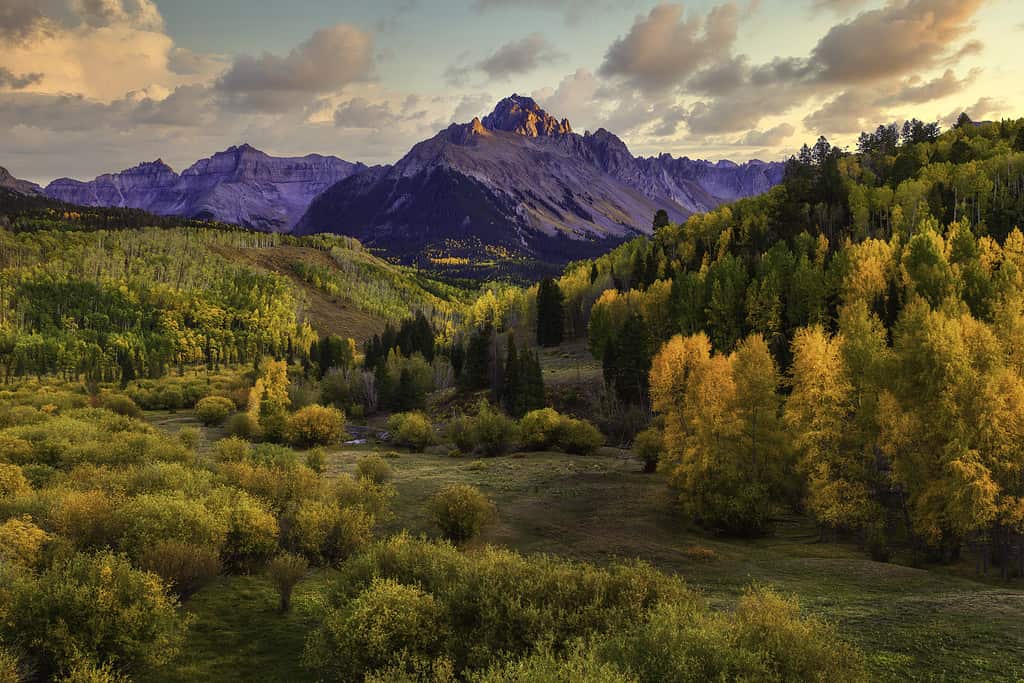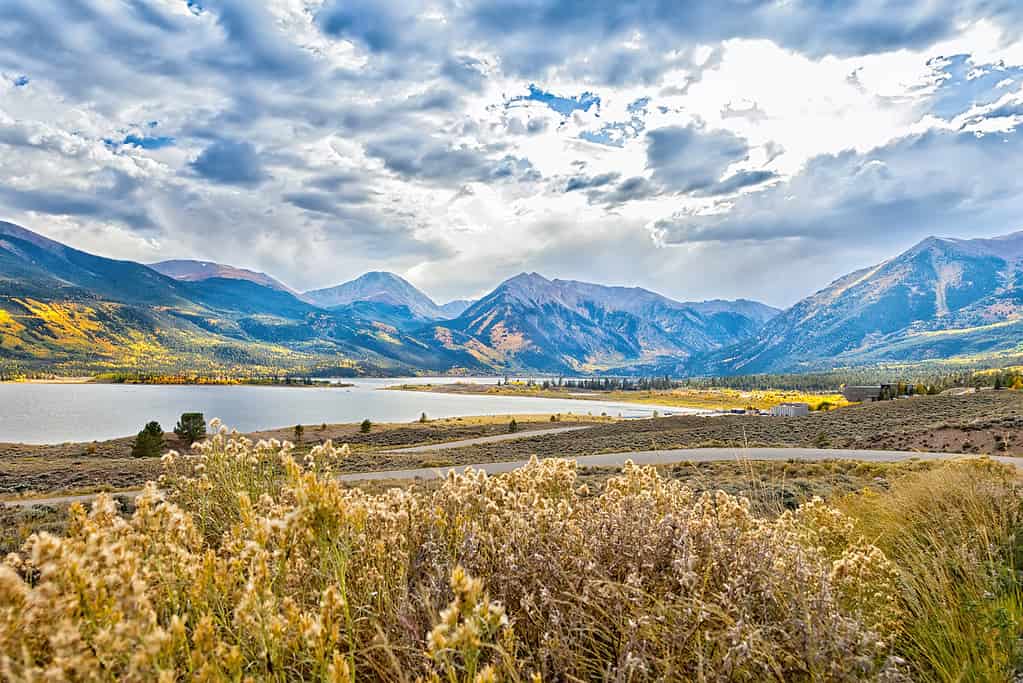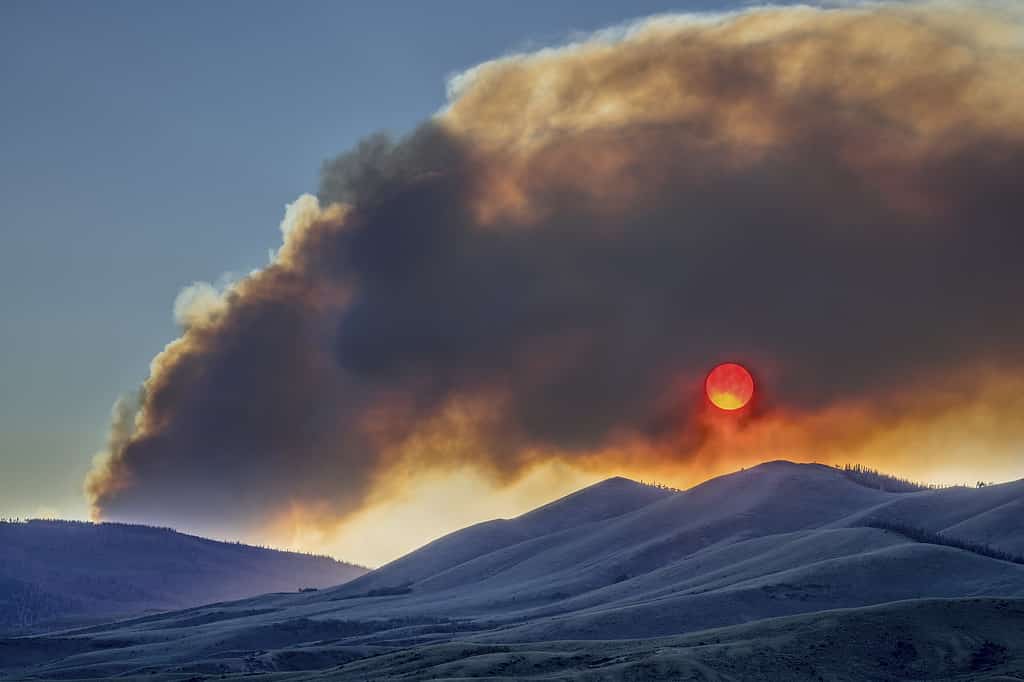Mount Sneffels emerges as a prominent and awe-inspiring peak in the San Juan Mountains of Colorado. With an impressive height, this majestic peak is one of Colorado’s Fourteeners. This article will explore how tall Mount Sneffels is, other peaks in the United States, as well as wildfire risks of mountain ranges such as the San Juan Mountains.
How Tall is Mount Sneffels?

Mount Sneffels, located within Colorado’s San Juan Mountains, has a prominence of 3,050 feet (930 meters).
©AndrewSoundarajan/iStock via Getty Images
Mount Sneffels, a towering and iconic peak in the picturesque state of Colorado, is a prominent figure in the Rocky Mountains. To truly understand the grandeur of this mountain, it is essential to delve into the measurements of elevation and prominence.
Elevation is a fundamental metric when assessing the stature of a mountain. It refers to the height above sea level, providing a direct indication of a mountain’s peak. In the case of Mount Sneffels, its elevation stands at an impressive 14,150 feet (4,315 meters) above sea level. Moreover, this towering altitude places it among the notable summits of the Colorado Rockies.
Now, let us explore the concept of prominence in topography. Prominence is the measure of a mountain’s independent significance, its autonomous height, or relative height. It is calculated as the height difference between the peak’s summit, the lowest contour line encircling it, and no higher summit. In simpler terms, it represents how much a mountain rises above its surrounding terrain. Furthermore, Mount Sneffels boasts a prominence of 3,050 feet (930 meters), making it a prominent and distinguishable peak in the San Juan Mountains.
Mountains like Mount Sneffels captivate the human imagination with their sheer presence and play a crucial role in the ecosystem, influencing weather patterns and harboring unique flora and fauna. They are vital to the natural world, and understanding their measurements, such as elevation and prominence, helps us appreciate their significance and ecological impact.
More About Mount Sneffels

Mount Sneffels is the tallest peak in the Sneffels Mountain Range, which is a part of the San Juan Mountain Range.
©RondaKimbrow/ via Getty Images
Location and Region
Mount Sneffels is located in the state of Colorado in the United States. Specifically, it graces the southwestern part of Colorado, in the San Juan Mountains. This region is renowned for its incredible rugged terrain, abundant wildlife, and pristine wilderness. The mountain resides within Ouray County, a place known for its stunning vistas and outdoor recreational opportunities. Due to its immense height, Mount Sneffels is considered a fourteener, which is any mountain with an elevation that measures over 14,000 feet. Moreover, it resides in the Mount Sneffels Wilderness, which is a part of the Uncompahgre National Forest.
The nearest town to Mount Sneffels is Ouray, CO. Ouray is approximately 10 miles (16 kilometers) east of the mountain. Moreover, this proximity to a popular mountain town provides accessibility for those who wish to embark on the adventure of exploring this remote peak.
Mountain Ranges
Mount Sneffels is the highest summit that is part of the Sneffels Mountain Range. Moreover, the Sneffels Mountain Range is a proud member of the San Juan Mountain Range, which is a prominent range in the Rocky Mountains of the American West. The San Juans are renowned for their rugged beauty, diverse ecosystems, and numerous peaks that are destinations for mountaineers and nature enthusiasts. Mount Sneffels is one of the most iconic summits within this range, offering an unforgettable experience to those who venture to its heights. It is one of the most photographed mountains in Colorado. Furthermore, as of 2023, Mount Sneffels is depicted on Colorado I.D. cards and driver’s licenses.
Origin of Its Name
Interestingly, Mount Sneffels was named after the Icelandic volcano Snæfell. This volcano resides on the Snæfellsnes peninsula in the country of Iceland. Furthermore, the volcano has a glacier called Snæfellsjökull. Snæfellsjökull covers the crater of Snæfell, similar to the shape of a convex lens. This is relevant because it was featured in the Jules Verne novel “Journey to the Center of the Earth.”
Wildlife
Mount Sneffels and the surrounding San Juan Mountains are home to a diverse array of wildlife, including mule deer, elk, black bears, cougars, bighorn sheep, and many bird species, to name a few. Moreover, the mountain’s alpine and subalpine ecosystems support unique flora and fauna adapted to high-altitude environments.
Geological History
The San Juan Mountains, including Mount Sneffels, have a rich geological history. They are primarily composed of Tertiary igneous rock, and their formation is linked to tectonic plate movements and volcanic activity. Furthermore, the rugged terrain and jagged peaks of the San Juans show the geological forces that shaped this region over millions of years.
Outdoor Recreation
Mount Sneffels offers a plethora of recreational opportunities for outdoor enthusiasts. Hiking and backpacking are popular activities around the mountain, with trails and routes of varying difficulty levels that include various classes of scrambling. Moreover, the mountain’s remote terrain attracts those seeking to conquer its summit to witness breathtaking views.
Conservation Efforts
The San Juan Mountains, including Mount Sneffels, benefit from conservation initiatives aimed at preserving their natural beauty and ecological integrity. Organizations and agencies, such as the United States Forest Service, work to protect these pristine landscapes and maintain them for the health of the environment and ecosystem and for future generations to enjoy.
Other Mountains of Significant Height in Colorado

Mount Elbert is the tallest peak in Colorado and the entirety of the Rocky Mountains, standing with an elevation of 14,440 feet (4,401 meters) and a prominence of 9,093 feet (2,772 meters).
©fallbrook/iStock via Getty Images
Colorado, often called the “Centennial State,” boasts an unparalleled wealth of natural beauty, particularly in its towering peaks and expansive mountain ranges. Beyond Mount Sneffels, let’s explore ten other remarkable peaks, their elevations, prominences, and locations in this captivating state.
Mount Elbert
Mount Elbert has an elevation of 14,440 feet (4,401 meters) and a prominence of 9,093 feet (2,772 meters). It is the highest peak in Colorado and the entire Rocky Mountains. Moreover, in the contiguous United States, it is the second-highest summit after Mount Whitney in California. Mount Elbert resides in the Sawatch Range in central Colorado.
Mount Massive
Sharing the Sawatch Range with Mount Elbert, Mount Massive stands at an elevation of 14,428 feet (4,398 meters). It has a prominence of 1,961 feet (598 meters). It ranks as the second-highest peak in Colorado, offering impressive vistas of the surrounding terrain. Moreover, it is also located in the Sawatch Range in central Colorado.
Longs Peak
Longs Peak is part of the northern Front Range of the Rocky Mountains and boasts an elevation of 14,259 feet (4,346 meters). Its prominence measures 2,940 feet (896 meters). Furthermore, it is a prime destination for climbers in Rocky Mountain National Park Wilderness.
Pikes Peak
Pikes Peak resides in the Front Range. It reaches an elevation of 14,115 feet (4,302 meters) and a prominence of 5,530 feet (1,690 meters). Moreover, its accessibility via the Pikes Peak Highway makes it a sought-after destination for many.
Blanca Peak
Blanca Peak reigns in the Sangre de Cristo Range of southern Colorado with an elevation of 14,351 feet (4,374 meters). Its prominence reaches 5,326 feet (1,623 meters). Furthermore, as one of Colorado’s Fourteeners, it stands as the fourth-highest summit in the Rocky Mountains and the state of Colorado. It is also the highest peak of the Sangre de Cristo Range.
Crestone Peak
Crestone Peak is also part of the Sangre de Cristo Range. It stands with an elevation of 14,300 feet (4,359 meters) and a prominence of 4,554 feet (1,388 meters). Moreover, it is a hotspot for climbers, and its challenging climbing routes attract climbers and mountaineers.
Mount Blue Sky
Located in the Front Range, west of Denver, Mount Evans rises to an elevation of 14,271 feet (4,350 meters). It has a prominence of 2,770 feet (844 meters). Furthermore, its accessibility by road makes it a popular destination for those seeking breathtaking views without intense physical effort.
Maroon Bells
In the Elk Mountains near Aspen, CO, Maroon Bells consists of two peaks, Maroon Peak and North Maroon Peak. Moreover, Maroon Peak reaches an elevation of 14,163 feet (4,317 meters) with a prominence of 2336 feet (712 meters). North Maroon Peak, meanwhile, reaches a lower elevation of 14,019 feet (4,273 meters).
Capitol Peak
Capitol Peak, also residing in the Elk Mountains and near Snowmass Village, boasts an elevation of 14,137 feet (4,309 meters). It has a prominence of 1,750 feet (533 meters). Furthermore, it has some of Colorado’s most challenging climbing routes and stunning vistas.
Uncompahgre Peak
Uncompahgre Peak is the highest point in the San Juan Mountains. Its elevation reaches 14,321 feet (4,365 meters), and it has a prominence of 4,277 feet (1,304 meters). Moreover, it resides in the Uncompahgre Wilderness within the northern San Juan Mountains.
These ten peaks, each with its unique characteristics and heights, collectively showcase the majesty of Colorado’s mountainous terrain. Colorado’s mountains offer a playground for outdoor recreation, from the towering heights of Mount Elbert and Pikes Peak to the rugged beauty of Crestone Peak and Capitol Peak.
Other Mountains of Significant Height in the United States

Located in Denali National Park and Preserve, AK, Denali, known by its former name Mount McKinley, is the highest mountain in North America, with an elevation of 20,310 feet (6,190 meters) and a prominence of 20,194 feet (6,155 meters).
©SteveAllenPhoto/iStock via Getty Images
Outside of Colorado, the United States is a land of diverse landscapes with towering peaks scattered across the country. While Colorado has many Fourteeners, there are numerous impressive mountains in other states as well. Here are ten more remarkable peaks from various regions of the United States, highlighting their elevations, prominences, and unique locations.
Denali (Mount McKinley) in Alaska
Denali, previously known as Mount McKinley, stands at the literal pinnacle of North America. Its elevation soars to a staggering 20,310 feet (6,190 meters). This makes it the tallest peak in the United States and North America. Denali’s prominence, the height it rises above its surrounding terrain, is an awe-inspiring 20,194 feet (6,155 meters). Moreover, from base to peak on land, it is the tallest mountain in the world, measuring 18,000 feet (5,500 meters).
Mount Rainier in Washington
Washington’s Mount Rainier, or Tahoma, is an iconic presence in the Cascade Range. Its elevation reaches 14,411 feet (4,392 meters), with a prominence of 13,246 feet (4,037 meters). This stratovolcano is not only the highest peak in Washington but also an active volcano. It is shrouded in glaciers and surrounded by lush forests.
Mount Whitney in California
In the heart of the Sierra Nevada Range stands Mount Whitney, soaring to an elevation of 14,505 feet (4,421 meters). It has a prominence of 10,075 feet (3,072 meters). Furthermore, this peak holds the distinction of being the highest point in the contiguous United States. With its incredible height and location, it offers stunning vistas of the surrounding wilderness.
Grand Teton in Wyoming
The Grand Teton is the tallest peak in Wyoming’s Teton Range. It reaches an elevation of 13,775 feet (4,199 meters) with a prominence of 6,530 feet (1,990 meters). Moreover, its distinctive shape and challenging climbing routes make it a favorite among mountaineers.
Mount Hood in Oregon
Oregon’s Mount Hood is part of the Cascade Mountains. It stands at an elevation of 11,249 feet (3,429 meters) with a prominence of 7,706 feet (2,349 meters). Furthermore, this stratovolcano has well-known symmetrical beauty and is a popular destination for hikers and mountaineers.
Mount Mitchell in North Carolina
Mount Mitchell, or Attakulla in Cherokee, is located in the Black Mountains of North Carolina. It holds the distinction of being the highest point in the eastern United States and the highest peak of the Appalachian Mountains. Its elevation is 6,684 feet (2,037 meters), with a prominence of 6,089 feet (1,856 meters). Moreover, the surrounding terrain offers a glimpse into the diverse ecosystems of the Appalachian Mountains.
Mount Shasta in California
In northern California, Mount Shasta rises to an elevation of 14,179 feet (4,322 meters). It has a prominence of 9,772 feet (2,979 meters). This stratovolcano is a prominent feature of the Cascade Range in Siskiyou County. Moreover, this mountain is also a part of the Shasta–Trinity National Forest.
Mount Katahdin in Maine
Mount Katahdin resides in Maine’s Baxter State Park. It reaches an elevation of 5,269 feet (1,606 meters) with a prominence of 4,288 feet (1,307 meters). Furthermore, as the northern terminus of the Appalachian Trail, it holds a special place in the hearts of nature enthusiasts.
Mount Washington in New Hampshire
New Hampshire’s Mount Washington, part of the White Mountains, is famous for its extreme weather conditions. Moreover, its elevation stands at 6,288 feet (1,917 meters) with a prominence of 6,148 feet (1,874 meters).
Mount Charleston in Nevada
Nevada’s Mount Charleston is also known as Charleston Peak. It rises to an elevation of 11,916 feet (3,632 meters) with a prominence of 8,241 feet (2,512 meters) in Clark County. It is the highest point in the Spring Mountains, offering a cool respite from the desert heat.
Dispersed across the United States, these ten peaks showcase the diversity and grandeur of the country’s mountainous landscapes. From the icy wilderness of Denali in Alaska to the lush beauty of Mount Katahdin in Maine, these mountains, just like Mount Sneffels, stand as examples of the incredibly tall natural wonders that can be found across the nation.
Wildfire Risk on Mount Sneffels and Mountain Ranges

Mountains and mountain ranges in North America are prone to wildfires during the summer months.
©marekuliasz/iStock via Getty Images
Mount Sneffels, like many mountainous regions, are naturally at risk of experiencing wildfires each year.
Wildfires in the Region
The San Juan Mountains, home to Mount Sneffels, are known for experiencing frequent wildfires each year. Moreover, these high-altitude environments tend to have a hotter and dryer climate, which can increase the frequency and intensity of wildfires.
Wildfire Season
As in many mountainous regions of the western United States, the wildfire season in the San Juan Mountains typically aligns with the warmer and drier months of late spring, summer, and early fall, often from May through September. This period, often referred to as “wildfire season,” is when vegetation becomes more susceptible to ignition due to reduced moisture levels and hot summer weather.
Factors Influencing Wildfires
Several factors contribute to the occurrence of wildfires in the San Juan Mountains and the broader region. Prolonged periods of drought can lead to reduced soil moisture and dry vegetation or even dead vegetation. These factors increase the risk of wildfires starting and spreading quickly. Moreover, lightning strikes can ignite fires in remote wilderness areas, especially during thunderstorms. Sadly, human activity, such as neglected campfires, discarded cigarettes, fireworks, and other human activities, can inadvertently start wildfires.
Wildfire Management
Efforts are in place to manage and mitigate wildfires in the San Juan Mountains and Colorado. In addition to all regions susceptible to wildfires, such as much of the western United States. Moreover, these efforts encompass intentional controlled fires, known as prescribed burns. Prescribed burns aim to reduce fuel buildup and decrease the risk of larger, uncontrolled wildfires. Additionally, fire management agencies work to educate the public about fire safety and implement fire restrictions during high-risk periods.
Wildfire and Ecological Role
It’s important to note that while wildfires can be destructive, they also play a natural role in many ecosystems. In some cases, fire can clear away dead vegetation, promote new growth, and even aid certain plant species in their life cycles. Moreover, these natural processes can be crucial for maintaining the health and diversity of the ecosystem.
Conclusion

Mount Sneffels has an elevation of 14,150 feet (4,315 meters) above sea level.
©AndrewSoundarajan/iStock via Getty Images
In conclusion, Mount Sneffels is a remarkable mountain located within Colorado’s San Juan Mountains. It has an elevation of 14,150 feet (4,315 meters) above sea level and a prominence of 3,050 feet (930 meters). Mount Sneffels commands attention as one of Colorado’s coveted “Fourteeners.” Furthermore, this prominent peak is a distinguished member of the San Juan Mountains. This region is renowned for its incredible mountainous terrain and pristine wilderness. Moreover, Mount Sneffels is the tallest point in the Sneffels Range.
Mount Sneffels’ geological history, primarily composed of Tertiary igneous rock, reveals the forces that have shaped this region over millions of years. The surrounding landscapes teem with diverse wildlife. This wildlife includes mule deer, elk, mountain goats, cougars, and black bears, thriving in varying ecosystems.
Mount Sneffels offers challenging hiking opportunities and a window into the wonders of the natural world through remote wilderness exploration. Tireless conservation efforts actively preserve the pristine beauty of the San Juan Mountains. Moreover, these efforts include public education about Leave No Trace principles and permit systems, all aimed at ensuring the ongoing protection, improvement of ecosystem health, and enjoyment of this majestic landscape for generations to come.
The photo featured at the top of this post is © Craig Zerbe/iStock via Getty Images
Thank you for reading! Have some feedback for us? Contact the AZ Animals editorial team.







